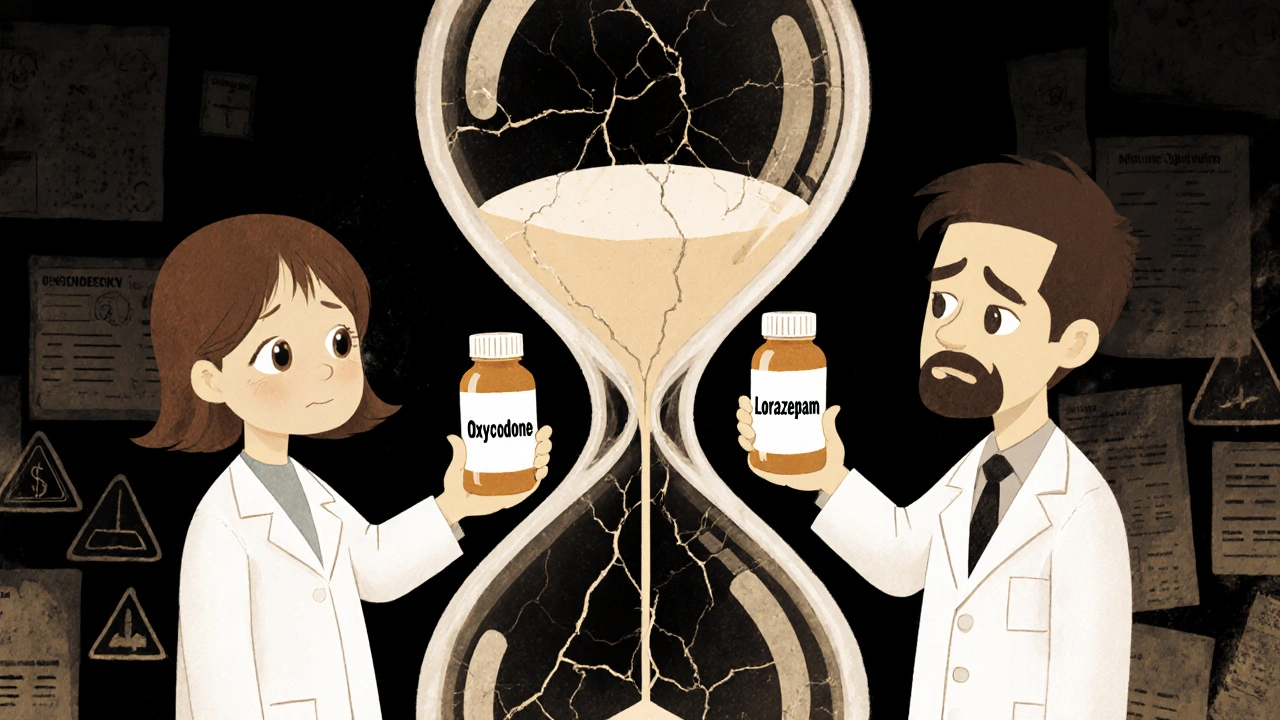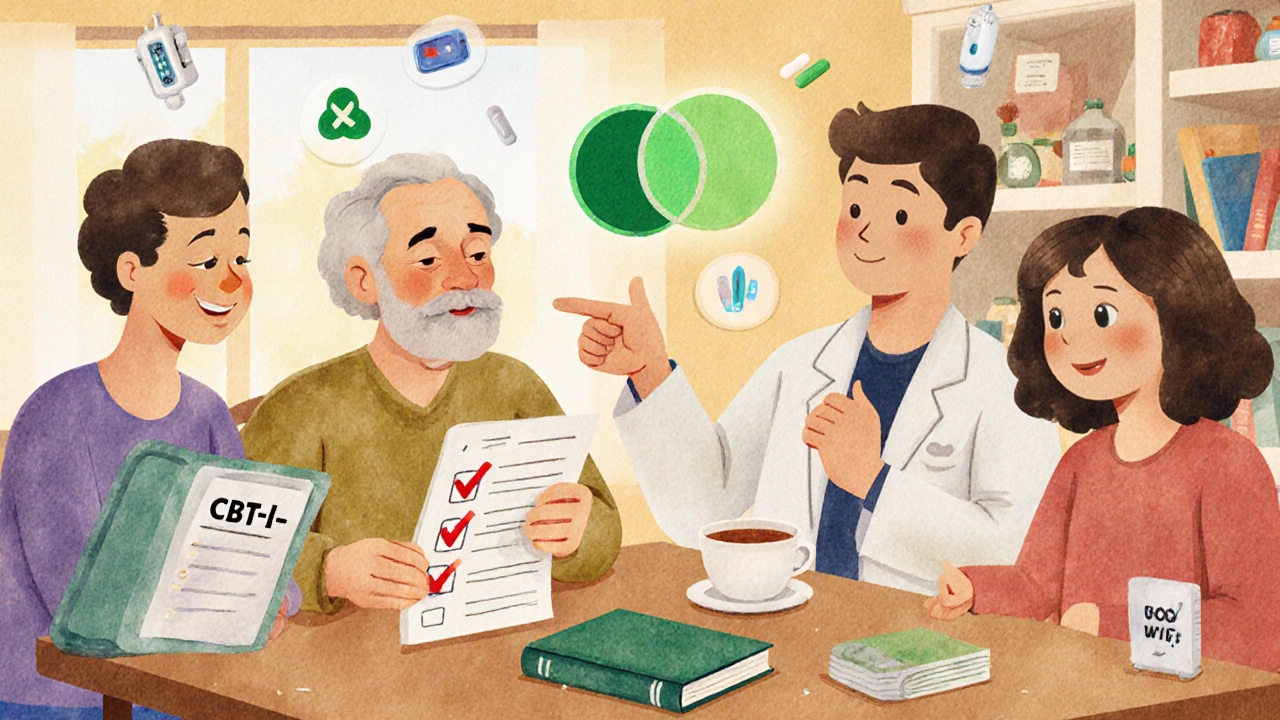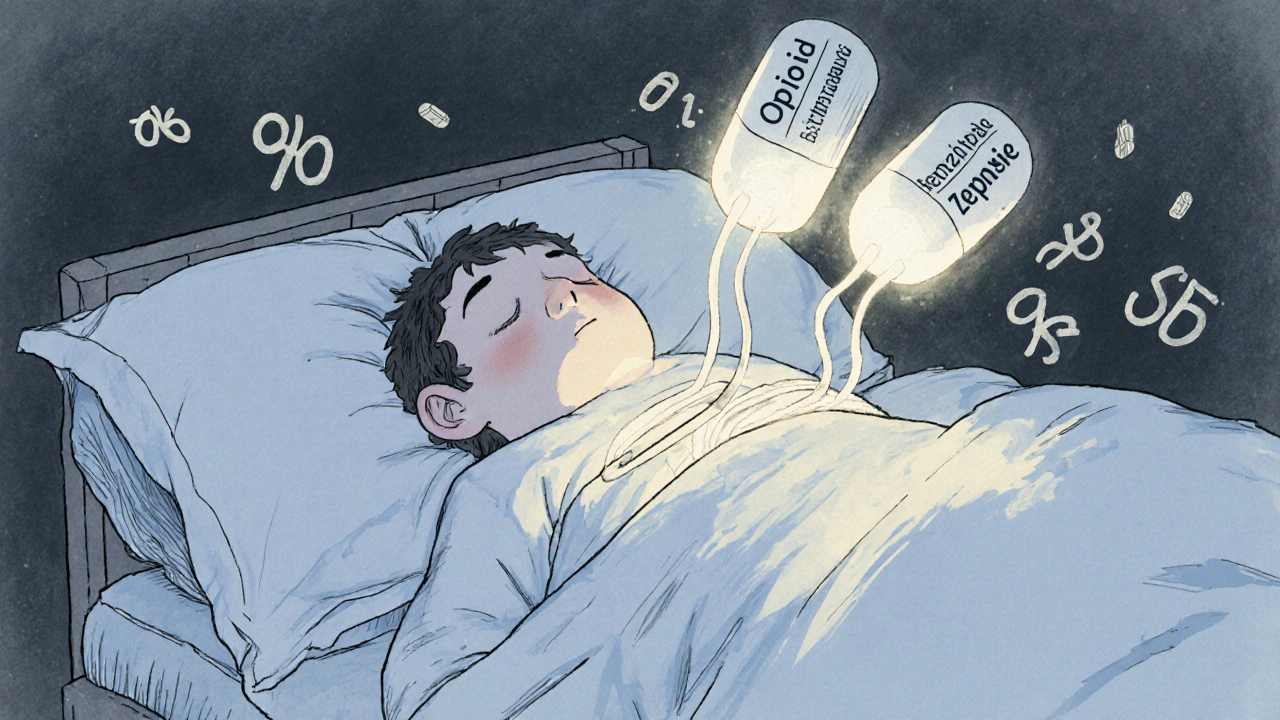When opioids and benzodiazepines are taken together, the risk of stopping breathing doesn’t just go up-it multiplies. This isn’t a hypothetical concern. It’s a leading cause of preventable death. In 2020, nearly 1 in 6 opioid-related overdose deaths in the U.S. involved benzodiazepines. That’s more than 220 people every day dying from a combination that doctors once thought was safe if doses were low.
Why This Combination Is So Dangerous
Opioids like oxycodone, hydrocodone, and fentanyl slow breathing by binding to receptors in the brainstem that control how hard and fast you breathe. Benzodiazepines like alprazolam, lorazepam, and diazepam do something similar-but through a different path. They boost GABA, a calming chemical in the brain that also quiets the signals telling your body to breathe. When you take both, these two drugs don’t just add up. They multiply. Studies show that people taking both drugs together have up to 10 times the risk of fatal respiratory depression compared to those taking opioids alone. One clinical study found that 85% of people given both drugs dropped their blood oxygen below 90%-a level that can cause brain damage or death during sleep. Only 45% of people taking opioids alone saw the same drop. This isn’t just about high doses. Even people taking what they think are "safe" amounts-like a low-dose Xanax for anxiety and a standard pain pill-can slip into respiratory failure, especially at night when their body’s natural breathing drive slows down.The Hidden Trap: Tolerance Doesn’t Protect You
Many assume that if someone has been on opioids for months, their body has adapted. They’ve built tolerance. So, they think, adding a benzodiazepine won’t be as risky. That’s a deadly myth. Tolerance to opioids doesn’t extend to benzodiazepines. Your body might handle the opioid just fine, but the benzodiazepine still hits your brainstem like a sledgehammer. A person who’s been on opioids for years can overdose on a single dose of a sleeping pill if they’ve never taken one before-or if they’ve taken it once years ago and forgotten how strong it is. This is why the FDA and CDC both warn that chronic opioid users are still at extreme risk when benzodiazepines are added. The body doesn’t build a shield against the combined effect. It just gets quieter-and that silence can be fatal.How the Body Breaks Down These Drugs-And Why That Makes It Worse
Some opioids, like fentanyl, methadone, and oxycodone, are broken down by a liver enzyme called CYP3A4. Many benzodiazepines-including alprazolam and midazolam-block that same enzyme. So when you take them together, the opioid doesn’t get cleared from your system like it should. It builds up. Your blood levels rise. The effect lasts longer. And your breathing gets slower and slower without you realizing it. This isn’t just theory. Emergency rooms see it all the time. Someone takes their regular pain pill and their nightly anxiety pill. They feel fine. They go to bed. By morning, they’re not breathing. No signs of struggle. No vomiting. Just stillness. The body doesn’t always scream before it stops. That’s what makes this interaction so sneaky.
Who’s Most at Risk?
Older adults are especially vulnerable. The American Geriatrics Society lists this combination as a "potentially inappropriate medication" for people over 65. Why? Because aging slows metabolism. The liver and kidneys don’t clear drugs as fast. Balance is already fragile. Add sedation, and the risk of falling-and then choking or stopping breathing-skyrockets. People with sleep apnea are another high-risk group. Their breathing already pauses during sleep. Add opioids or benzodiazepines, and those pauses get longer. Deeper. More frequent. A 2022 CDC-funded study found that patients with sleep apnea on this combination had a 15-fold higher chance of respiratory arrest than those without the condition. Even people with no history of substance abuse are at risk. This isn’t just about "drug seekers." It’s about someone with chronic back pain prescribed oxycodone, and then a doctor adds lorazepam for anxiety or insomnia. Neither drug is "abused." Both are prescribed legally. And together, they become a silent killer.What Doctors Are Doing About It
The FDA issued its first warning about this interaction in 2016. By 2019, they mandated a "Boxed Warning"-the strongest possible alert-on the labels of all opioids and many benzodiazepines. The warning is clear: combining these drugs can cause extreme sleepiness, slowed or stopped breathing, coma, or death. The CDC’s 2022 guidelines say this outright: "Avoid prescribing benzodiazepines concurrently with opioids whenever possible." In hospitals and clinics, electronic health records now flag dangerous combinations before a prescription is written. One study showed that these alerts reduced inappropriate co-prescribing by 27% in just one year. But prescriptions still happen. A 2021 study found that 15% of Medicare patients on long-term opioids were also getting benzodiazepines. In 4.3% of cases, the combination involved extended-release opioids and long-acting benzodiazepines-the most dangerous pairing.What to Do If You’re Already Taking Both
If you’re on both medications, don’t stop suddenly. Abruptly quitting benzodiazepines can trigger seizures. Stopping opioids too fast can cause severe withdrawal: sweating, shaking, nausea, anxiety, and heart palpitations. Talk to your doctor about a taper plan. That means slowly reducing one or both drugs over weeks or months, under supervision. Sometimes, switching to a non-sedating pain medication or a non-benzodiazepine sleep aid can help. Options like gabapentin, melatonin, or cognitive behavioral therapy for insomnia (CBT-I) have shown success in reducing reliance on these dangerous combinations. Never take alcohol with either drug. Alcohol makes the breathing depression worse. It’s not "just one drink." It’s a multiplier.
Signs You or Someone Else Is in Danger
Know the warning signs. They’re not always dramatic:- Unusual drowsiness-even after a full night’s sleep
- Slurred speech or confusion
- Slow, shallow breathing (fewer than 10 breaths per minute)
- Blue lips or fingertips
- Difficulty waking up, even when shaken
The Bigger Picture: Why This Keeps Happening
This isn’t just about bad prescribing. It’s about fragmented care. One doctor prescribes the opioid for pain. Another prescribes the benzodiazepine for anxiety. Neither knows what the other has written. Patients don’t always tell their doctors everything they’re taking. The solution isn’t just more warnings. It’s better communication. It’s pharmacists checking for interactions before dispensing. It’s patients bringing a full list of every pill, patch, and supplement to every appointment. It’s also about finding alternatives. There are non-opioid pain treatments: physical therapy, nerve blocks, certain antidepressants. For anxiety and insomnia, there’s CBT, mindfulness, and non-sedating medications like buspirone.What You Can Do Today
If you’re on opioids or benzodiazepines:- Ask your doctor: "Could I be at risk from taking these together?"
- Ask: "Is there a safer alternative?"
- Ask: "Should I carry naloxone?"
- Teach a family member or roommate how to recognize the signs of overdose-and how to use naloxone if available.
- Keep a written list of all your medications and update it every time you see a new provider.
Can you die from taking opioids and benzodiazepines together even at low doses?
Yes. Even low doses can be deadly when combined. The interaction between these drugs isn’t linear-it’s synergistic, meaning their effects multiply. Someone taking a standard dose of oxycodone and a low-dose alprazolam can experience respiratory depression severe enough to stop breathing, especially during sleep. The body doesn’t build tolerance to the combined effect, so even experienced users are at risk.
Does naloxone reverse a benzodiazepine overdose?
No. Naloxone only reverses opioid overdoses. It has no effect on benzodiazepines. However, if opioids are part of the mix-common in fatal overdoses-naloxone can still save a life by reversing the opioid component. It should be administered immediately if overdose is suspected, while emergency services are called.
Why do doctors still prescribe these together?
Sometimes, it’s because they’re unaware of the full risk, or because the patient has multiple conditions-chronic pain and severe anxiety-that seem hard to treat otherwise. Fragmented care plays a role: one provider prescribes for pain, another for anxiety, and communication breaks down. But current guidelines from the CDC and FDA strongly advise against it. When it’s unavoidable, dosages are kept as low as possible, and close monitoring is required.
Can I stop one of these medications on my own?
No. Stopping benzodiazepines suddenly can cause seizures, hallucinations, or life-threatening withdrawal. Stopping opioids abruptly can cause severe flu-like symptoms and intense cravings. Always work with your doctor to create a safe, gradual tapering plan. Never quit cold turkey.
Are there safer alternatives to opioids and benzodiazepines?
Yes. For pain, options include physical therapy, acupuncture, NSAIDs, certain antidepressants (like duloxetine), and nerve blocks. For anxiety and insomnia, cognitive behavioral therapy (CBT), mindfulness practices, melatonin, and non-sedating medications like buspirone are effective and carry no respiratory risk. Many patients find long-term relief without opioids or benzodiazepines.
Is this interaction only a problem in the U.S.?
No. While U.S. data is the most detailed, this risk exists globally. The World Health Organization and European Medicines Agency have issued similar warnings. Countries with high opioid prescribing rates, including Canada, Australia, and the UK, also report rising deaths from this combination. It’s a worldwide public health issue.


Comments
Manish Pandya
Just read this and my heart sank. My uncle took oxycodone for his back and Xanax for anxiety-both prescribed. He never touched alcohol or street drugs. One morning, he just didn’t wake up. No struggle. No noise. Just silence. This isn’t about addiction-it’s about medical ignorance. Doctors need to stop treating symptoms like puzzle pieces and start seeing the whole body.
November 26, 2025 at 10:02
Lawrence Zawahri
THIS IS ALL A BIG PHARMA LIE. They want you dependent. They made opioids and benzos to keep you hooked so you keep buying. The FDA? Controlled by Big Pharma. The CDC? A puppet. They don’t care if you die-they care if you keep paying for pills. Wake up, sheeple. The real killer isn’t the drugs-it’s the system that pushes them.
November 27, 2025 at 06:42
Benjamin Gundermann
Look, I get it. We’re all just trying to survive these days, right? Pain sucks. Anxiety is a beast. But combining these two? It’s like lighting a candle in a gas leak. You don’t need to be a genius to see it’s gonna blow. And yeah, I know-doctors are busy, insurance is a nightmare, and therapy costs more than a Netflix subscription. But here’s the thing: we’ve been sold a myth that pills are the only way. They’re not. There’s yoga, there’s therapy, there’s just… breathing. I know, I know-sounds hippie. But hey, I’m alive. And my grandma’s still walking. She never took a benzo. Just walks every morning. Weird, right?
November 28, 2025 at 05:53
Rachelle Baxter
OMG. I’m so mad right now. 😤 This is why I refuse to take anything prescribed unless it’s absolutely necessary. My cousin died from this exact combo. Two perfectly legal prescriptions. And the doctor didn’t even mention the risk?! 🤬 I’m telling everyone I know. If you’re on opioids or benzos, ASK. ASK. ASK. And if they say it’s fine? Get a second opinion. And maybe a lawyer. This is medical malpractice waiting to happen. #WakeUpAmerica
November 28, 2025 at 11:55
Dirk Bradley
It is an incontrovertible fact, grounded in empirical pharmacological research, that the concomitant administration of opioid analgesics and benzodiazepinergic agents engenders a synergistic depressant effect upon the central respiratory centers, thereby precipitating a statistically significant elevation in mortality risk. The failure of prescribers to acknowledge this interaction constitutes a grievous breach of the Hippocratic Oath. One must wonder whether the commodification of healthcare has supplanted clinical judgment in the modern medical ecosystem.
November 28, 2025 at 12:45
Emma Hanna
Wait. Wait. Wait. So you’re telling me… people… are still… doing this?!?!?!?!? Like, on purpose?!?!? With prescriptions?!?!? That’s not just irresponsible-that’s criminal. And don’t even get me started on the fact that people think they’re safe because they’re "low dose." Low dose?!?!? Low dose doesn’t mean safe when you’re combining two drugs that literally turn your brainstem into a mute button. I’m shaking.
November 29, 2025 at 05:05
Mariam Kamish
lol. So now we’re blaming doctors? 😒 I’ve been on both for years. I’m fine. Everyone else is just weak. If you can’t handle a little sleepiness, maybe you shouldn’t be on meds at all. Also, naloxone? Pfft. Like that’s gonna help if you’re just being lazy and not managing your life. 🤷♀️
November 29, 2025 at 08:31
Adesokan Ayodeji
My friend in Lagos lost his father to this exact thing. Both drugs were prescribed by different clinics. No one talked. No one checked. His dad was 68, had diabetes and sleep apnea-perfect storm. But here’s the thing: it didn’t have to happen. There are so many alternatives-acupuncture, physical therapy, even simple breathing exercises. I’ve seen people with chronic pain go from bedridden to hiking in the mountains without opioids. It takes time. It takes patience. But it’s possible. You’re not alone. Reach out. Talk to someone. There’s help. You’re not broken. You’re just trying to survive. And you deserve better than this.
November 30, 2025 at 06:16
Karen Ryan
I’m from the U.S., but my mom’s from Japan. She had chronic pain after her hip surgery. They tried opioids-she got dizzy, nauseous. Then they gave her a benzo for sleep. She slept for 18 hours straight. We thought it was the meds. Turns out, it was the combo. We switched to tai chi, massage, and melatonin. She’s been pain-free for two years now. No pills. Just movement and quiet. I wish more doctors here knew about these options. It’s not about giving up. It’s about finding a different way.
November 30, 2025 at 19:58
Kaylee Crosby
I work in ER. We see this every week. Someone’s quiet. No struggle. Just… gone. No signs. No screams. Just a phone call from a family member saying "they didn’t wake up." And every time, it’s the same combo. I wish I could tell every patient I see: "Please, just ask your doctor if you really need both." It’s not weakness to ask. It’s survival. And if you’re scared to talk to your doctor? Bring someone with you. A friend. A sibling. Someone who cares. You don’t have to do this alone.
December 1, 2025 at 17:17
Terry Bell
man i used to think i was tough cause i could handle my pain and my anxiety. but then i realized… i was just numb. not healed. just numb. i started going to therapy instead of popping pills. it sucked at first. like, really sucked. crying in a chair for an hour? weird. but now? i sleep better. i breathe better. i feel more. not less. i’m not saying it’s easy. but it’s worth it. you don’t need to be a hero to live. you just need to be willing to try something new.
December 2, 2025 at 21:25
Patrick Goodall
THIS IS THE NEW GATEKEEPING. They don’t want you feeling better. They want you dependent. Look at the stats-doctors still prescribe this combo. Why? Because they’re paid to. Because the system is rigged. And the FDA? They’re just window dressing. I’ve seen people get cut off cold turkey from opioids and thrown into withdrawal hell while benzos are still being pushed. This isn’t medicine. It’s control. Wake up. The system doesn’t care if you live. It cares if you keep paying.
December 3, 2025 at 17:30
Jacqueline Aslet
One must question the epistemological foundations of contemporary pharmacological practice. If the synergistic lethality of opioid-benzodiazepine co-administration is empirically established, and if regulatory bodies have issued formal warnings, then the persistence of this practice constitutes not merely negligence, but a systemic failure of medical ethics. The individual physician, acting within a fragmented care architecture, becomes an unwitting agent of a broader institutional malpractice. To attribute blame to the prescriber alone is to ignore the structural rot.
December 4, 2025 at 09:22
Write a comment